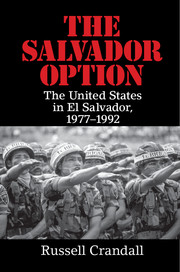Book contents
- Frontmatter
- Dedication
- Epigraph
- Contents
- List of Figures
- List of Organizations
- Acknowledgments
- 1 Introduction
- PART ONE EL SALVADOR IN THE COLD WAR
- PART TWO JIMMY CARTER
- 7 Revolution and Counterinsurgency in Guatemala
- 8 Mass Organizations
- 9 Carter Arrives
- 10 Carter and the Sandinista Revolution in Nicaragua, 1979
- 11 An October Coup
- 12 Carter Engages Salvador
- 13 Archbishop Romero
- 14 Land
- 15 The American Churchwomen
- 16 Arming the Rebels
- 17 Guerrilla Final Offensive, January 1981
- 18 Death Squads
- PART THREE RONALD REAGAN
- PART FOUR GEORGE H. W. BUSH
- PART FIVE POSTWAR
- Notes
- Bibliography
- Index
10 - Carter and the Sandinista Revolution in Nicaragua, 1979
from PART TWO - JIMMY CARTER
Published online by Cambridge University Press: 05 June 2016
- Frontmatter
- Dedication
- Epigraph
- Contents
- List of Figures
- List of Organizations
- Acknowledgments
- 1 Introduction
- PART ONE EL SALVADOR IN THE COLD WAR
- PART TWO JIMMY CARTER
- 7 Revolution and Counterinsurgency in Guatemala
- 8 Mass Organizations
- 9 Carter Arrives
- 10 Carter and the Sandinista Revolution in Nicaragua, 1979
- 11 An October Coup
- 12 Carter Engages Salvador
- 13 Archbishop Romero
- 14 Land
- 15 The American Churchwomen
- 16 Arming the Rebels
- 17 Guerrilla Final Offensive, January 1981
- 18 Death Squads
- PART THREE RONALD REAGAN
- PART FOUR GEORGE H. W. BUSH
- PART FIVE POSTWAR
- Notes
- Bibliography
- Index
Summary
If any nation, whatever its political system, deprives its people of basic human rights, that fact will help shape our own people's attitude toward that nation's repressive government.…[W]e should use our tremendous influence to increase freedom, particularly in those countries that depend upon us for their very survival.
– President Jimmy Carter during the 1976 presidential campaignIn the early morning of January 10, 1978, Pedro Joaquín Chamorro, a prominent Nicaraguan political figure and head of the opposition newspaper La Prensa, was driving in Managua when a green Toyota truck suddenly swerved in front of him. Two men leaped out of the truck and fired shotgun blasts at Chamorro's vehicle, then jumped into a waiting car and sped away. Chamorro was rushed to a nearby hospital but died on the way. Nicaragua's strongman, Anastasio “Tachito” Somoza, the second son of the Somoza who killed the nationalist guerrilla Sandino and seized power in the early 1930s, claimed that the assassination had been perpetrated by opposition members themselves to implicate the increasingly despised regime.
Few Nicaraguans believed this version of the story. Instead, they blamed Somoza for the extrajudicial killing, and their eagerness to get rid of the dynastic dictatorship increased significantly. In the aftermath of Chamorro's public funeral, youth in cities across the country tossed homemade bombs at military jeeps and shot at the Nicaraguan National Guard (Guardia Nacional de Nicaragua) posts with hunting rifles. In their first coordinated anti-Somoza move, business leaders called a national strike demanding that Chamorro's killers be found and tried. Chamorro's death became the spark for the conflagration that sealed Somoza's dramatic downfall and initiated a Marxist revolution in Nicaragua.
Many focos were attempted in Latin America during the 1960s and ’70s, from Guatemala to Venezuela and down to Bolivia and Argentina, but almost all failed at the hands of counterinsurgent forces, often trained and funded by Washington. Despite this trend, the Sandinistas took inspiration from the Cuban foco thesis that a small group of highly dedicated insurgents could spark a triumphant national revolution. Given this historical context, the revolution was deeply influential for Marxist guerrillas operating in the jungles and mountains across the region – most notably in El Salvador and Guatemala – who witnessed the Sandinistas’ rapid and total victory over what was long believed to be an impregnable Somoza regime.
- Type
- Chapter
- Information
- The Salvador OptionThe United States in El Salvador, 1977–1992, pp. 114 - 121Publisher: Cambridge University PressPrint publication year: 2016

